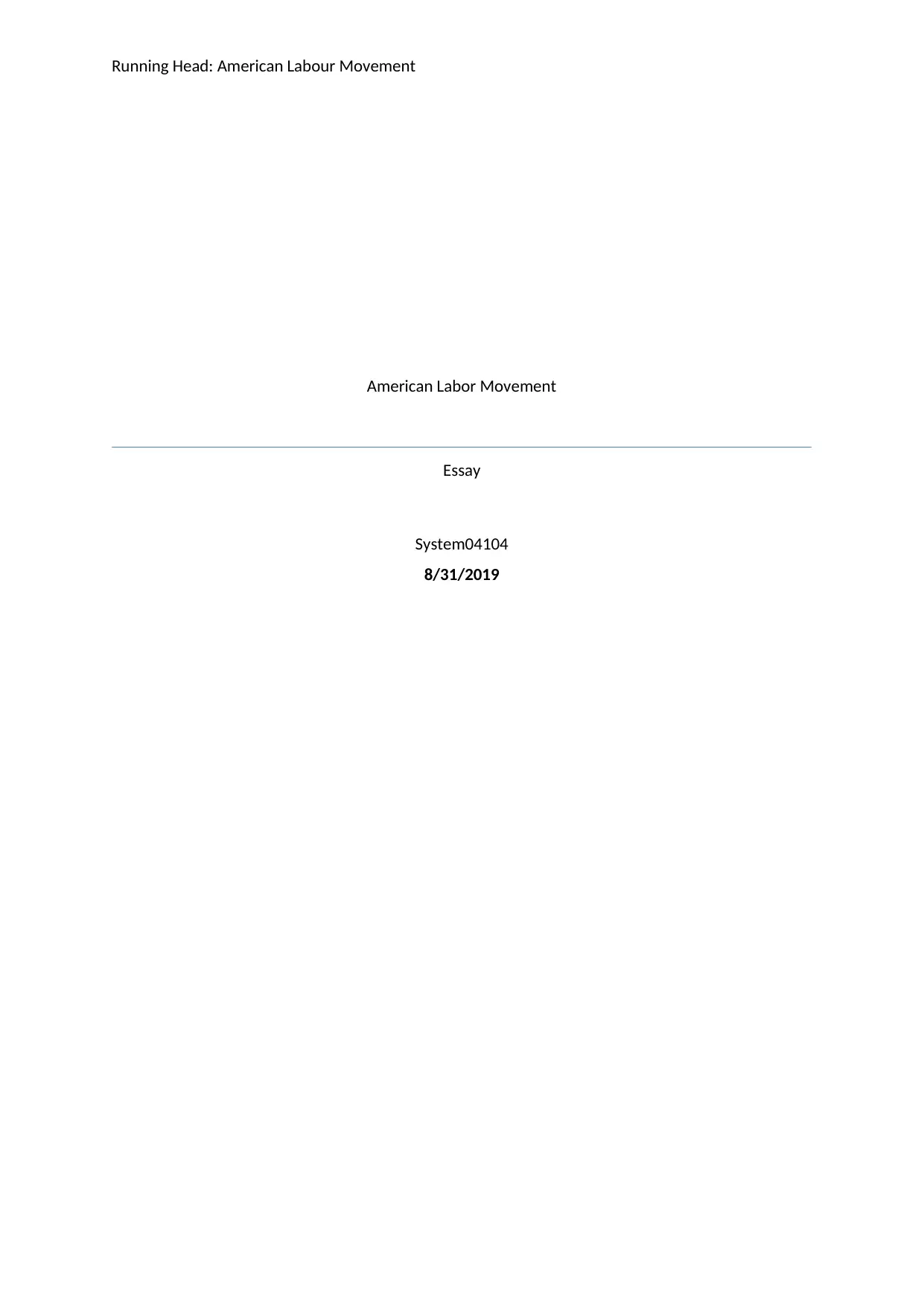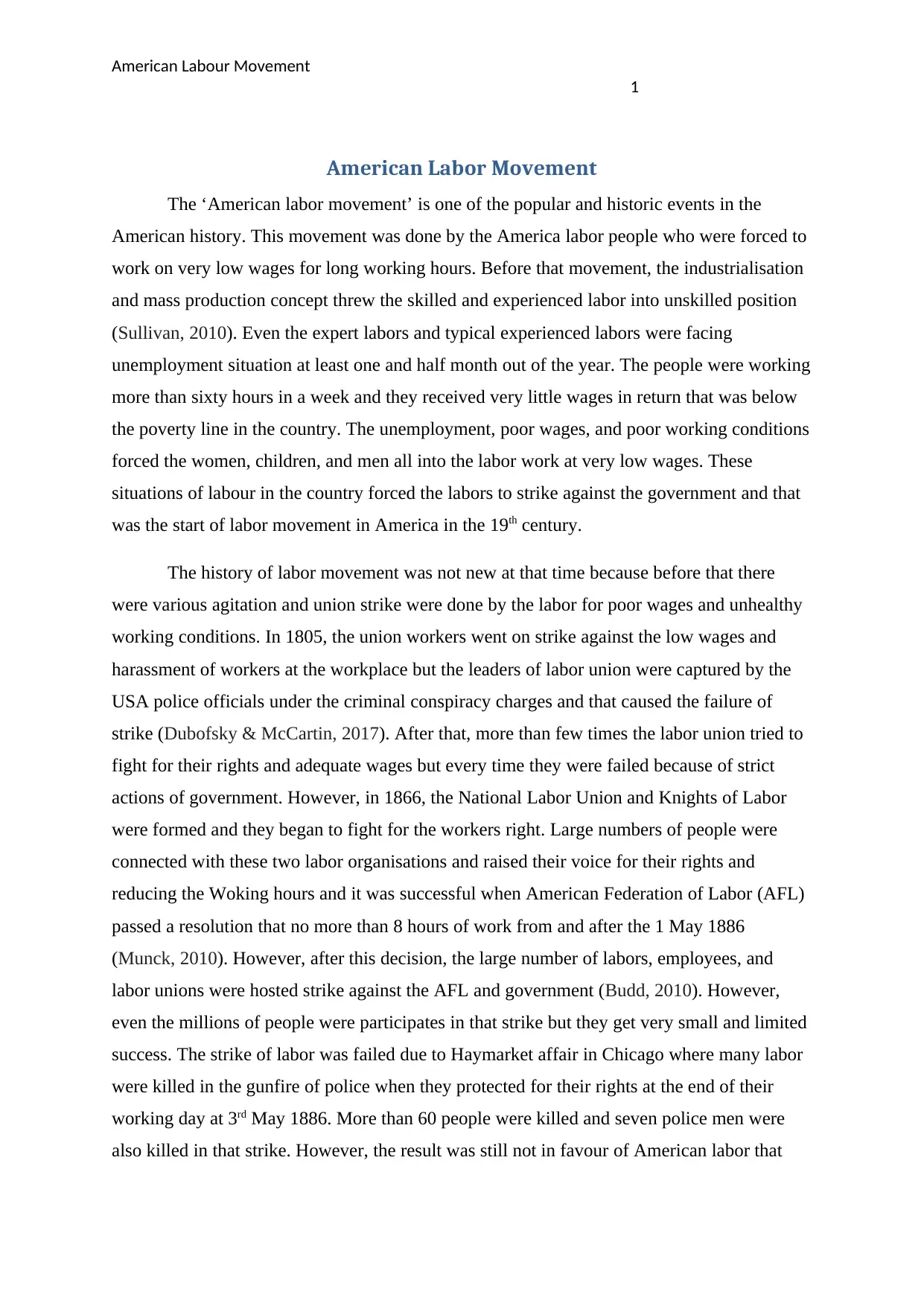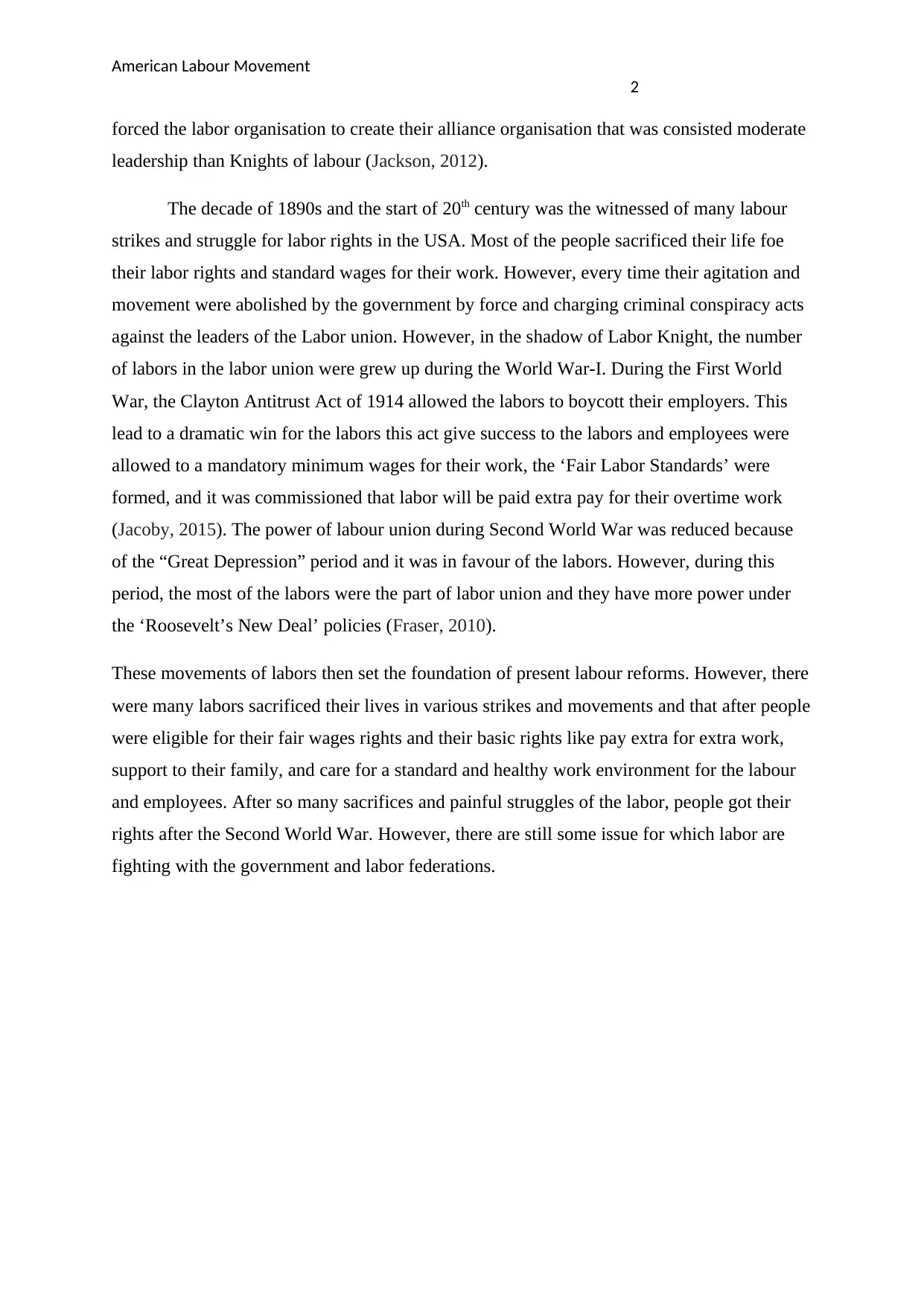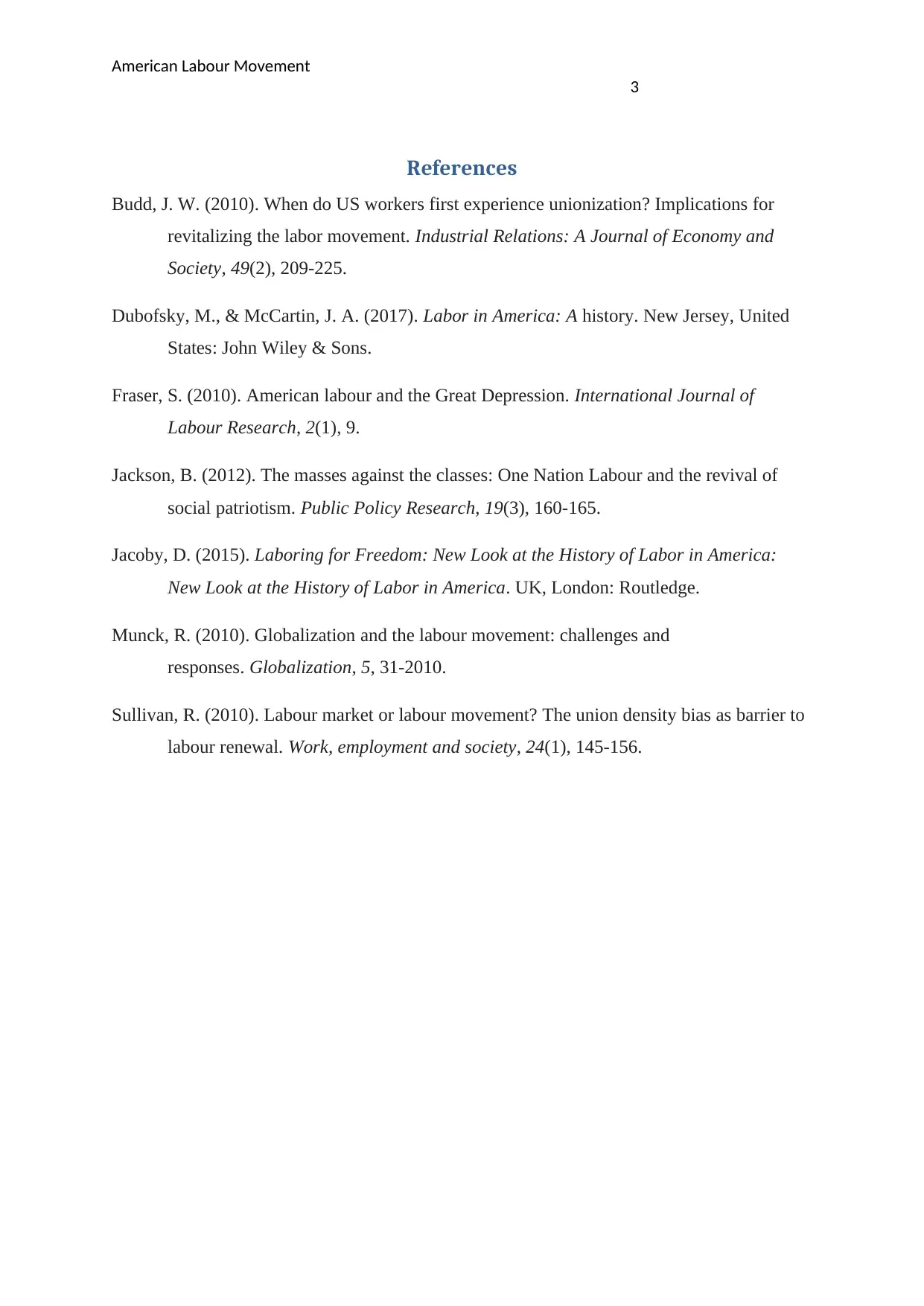Essay on the History and Significance of American Labor Movement
VerifiedAdded on 2022/12/23
|4
|1136
|1
Essay
AI Summary
This essay provides a historical overview of the American Labor Movement, tracing its origins in the 19th century amidst industrialization and poor working conditions. It details the struggles of laborers, including strikes, union formations like the National Labor Union, Knights of Labor, and the American Federation of Labor (AFL), and the challenges faced due to government actions and events like the Haymarket affair. The essay highlights key legislative achievements such as the Clayton Antitrust Act and the Fair Labor Standards, and the impact of events like the Great Depression and the World Wars. It emphasizes the sacrifices made by laborers in their fight for fair wages, improved working conditions, and basic rights, setting the foundation for present labor reforms, while also acknowledging ongoing challenges.

Running Head: American Labour Movement
American Labor Movement
Essay
System04104
8/31/2019
American Labor Movement
Essay
System04104
8/31/2019
Paraphrase This Document
Need a fresh take? Get an instant paraphrase of this document with our AI Paraphraser

American Labour Movement
1
American Labor Movement
The ‘American labor movement’ is one of the popular and historic events in the
American history. This movement was done by the America labor people who were forced to
work on very low wages for long working hours. Before that movement, the industrialisation
and mass production concept threw the skilled and experienced labor into unskilled position
(Sullivan, 2010). Even the expert labors and typical experienced labors were facing
unemployment situation at least one and half month out of the year. The people were working
more than sixty hours in a week and they received very little wages in return that was below
the poverty line in the country. The unemployment, poor wages, and poor working conditions
forced the women, children, and men all into the labor work at very low wages. These
situations of labour in the country forced the labors to strike against the government and that
was the start of labor movement in America in the 19th century.
The history of labor movement was not new at that time because before that there
were various agitation and union strike were done by the labor for poor wages and unhealthy
working conditions. In 1805, the union workers went on strike against the low wages and
harassment of workers at the workplace but the leaders of labor union were captured by the
USA police officials under the criminal conspiracy charges and that caused the failure of
strike (Dubofsky & McCartin, 2017). After that, more than few times the labor union tried to
fight for their rights and adequate wages but every time they were failed because of strict
actions of government. However, in 1866, the National Labor Union and Knights of Labor
were formed and they began to fight for the workers right. Large numbers of people were
connected with these two labor organisations and raised their voice for their rights and
reducing the Woking hours and it was successful when American Federation of Labor (AFL)
passed a resolution that no more than 8 hours of work from and after the 1 May 1886
(Munck, 2010). However, after this decision, the large number of labors, employees, and
labor unions were hosted strike against the AFL and government (Budd, 2010). However,
even the millions of people were participates in that strike but they get very small and limited
success. The strike of labor was failed due to Haymarket affair in Chicago where many labor
were killed in the gunfire of police when they protected for their rights at the end of their
working day at 3rd May 1886. More than 60 people were killed and seven police men were
also killed in that strike. However, the result was still not in favour of American labor that
1
American Labor Movement
The ‘American labor movement’ is one of the popular and historic events in the
American history. This movement was done by the America labor people who were forced to
work on very low wages for long working hours. Before that movement, the industrialisation
and mass production concept threw the skilled and experienced labor into unskilled position
(Sullivan, 2010). Even the expert labors and typical experienced labors were facing
unemployment situation at least one and half month out of the year. The people were working
more than sixty hours in a week and they received very little wages in return that was below
the poverty line in the country. The unemployment, poor wages, and poor working conditions
forced the women, children, and men all into the labor work at very low wages. These
situations of labour in the country forced the labors to strike against the government and that
was the start of labor movement in America in the 19th century.
The history of labor movement was not new at that time because before that there
were various agitation and union strike were done by the labor for poor wages and unhealthy
working conditions. In 1805, the union workers went on strike against the low wages and
harassment of workers at the workplace but the leaders of labor union were captured by the
USA police officials under the criminal conspiracy charges and that caused the failure of
strike (Dubofsky & McCartin, 2017). After that, more than few times the labor union tried to
fight for their rights and adequate wages but every time they were failed because of strict
actions of government. However, in 1866, the National Labor Union and Knights of Labor
were formed and they began to fight for the workers right. Large numbers of people were
connected with these two labor organisations and raised their voice for their rights and
reducing the Woking hours and it was successful when American Federation of Labor (AFL)
passed a resolution that no more than 8 hours of work from and after the 1 May 1886
(Munck, 2010). However, after this decision, the large number of labors, employees, and
labor unions were hosted strike against the AFL and government (Budd, 2010). However,
even the millions of people were participates in that strike but they get very small and limited
success. The strike of labor was failed due to Haymarket affair in Chicago where many labor
were killed in the gunfire of police when they protected for their rights at the end of their
working day at 3rd May 1886. More than 60 people were killed and seven police men were
also killed in that strike. However, the result was still not in favour of American labor that

American Labour Movement
2
forced the labor organisation to create their alliance organisation that was consisted moderate
leadership than Knights of labour (Jackson, 2012).
The decade of 1890s and the start of 20th century was the witnessed of many labour
strikes and struggle for labor rights in the USA. Most of the people sacrificed their life foe
their labor rights and standard wages for their work. However, every time their agitation and
movement were abolished by the government by force and charging criminal conspiracy acts
against the leaders of the Labor union. However, in the shadow of Labor Knight, the number
of labors in the labor union were grew up during the World War-I. During the First World
War, the Clayton Antitrust Act of 1914 allowed the labors to boycott their employers. This
lead to a dramatic win for the labors this act give success to the labors and employees were
allowed to a mandatory minimum wages for their work, the ‘Fair Labor Standards’ were
formed, and it was commissioned that labor will be paid extra pay for their overtime work
(Jacoby, 2015). The power of labour union during Second World War was reduced because
of the “Great Depression” period and it was in favour of the labors. However, during this
period, the most of the labors were the part of labor union and they have more power under
the ‘Roosevelt’s New Deal’ policies (Fraser, 2010).
These movements of labors then set the foundation of present labour reforms. However, there
were many labors sacrificed their lives in various strikes and movements and that after people
were eligible for their fair wages rights and their basic rights like pay extra for extra work,
support to their family, and care for a standard and healthy work environment for the labour
and employees. After so many sacrifices and painful struggles of the labor, people got their
rights after the Second World War. However, there are still some issue for which labor are
fighting with the government and labor federations.
2
forced the labor organisation to create their alliance organisation that was consisted moderate
leadership than Knights of labour (Jackson, 2012).
The decade of 1890s and the start of 20th century was the witnessed of many labour
strikes and struggle for labor rights in the USA. Most of the people sacrificed their life foe
their labor rights and standard wages for their work. However, every time their agitation and
movement were abolished by the government by force and charging criminal conspiracy acts
against the leaders of the Labor union. However, in the shadow of Labor Knight, the number
of labors in the labor union were grew up during the World War-I. During the First World
War, the Clayton Antitrust Act of 1914 allowed the labors to boycott their employers. This
lead to a dramatic win for the labors this act give success to the labors and employees were
allowed to a mandatory minimum wages for their work, the ‘Fair Labor Standards’ were
formed, and it was commissioned that labor will be paid extra pay for their overtime work
(Jacoby, 2015). The power of labour union during Second World War was reduced because
of the “Great Depression” period and it was in favour of the labors. However, during this
period, the most of the labors were the part of labor union and they have more power under
the ‘Roosevelt’s New Deal’ policies (Fraser, 2010).
These movements of labors then set the foundation of present labour reforms. However, there
were many labors sacrificed their lives in various strikes and movements and that after people
were eligible for their fair wages rights and their basic rights like pay extra for extra work,
support to their family, and care for a standard and healthy work environment for the labour
and employees. After so many sacrifices and painful struggles of the labor, people got their
rights after the Second World War. However, there are still some issue for which labor are
fighting with the government and labor federations.
⊘ This is a preview!⊘
Do you want full access?
Subscribe today to unlock all pages.

Trusted by 1+ million students worldwide

American Labour Movement
3
References
Budd, J. W. (2010). When do US workers first experience unionization? Implications for
revitalizing the labor movement. Industrial Relations: A Journal of Economy and
Society, 49(2), 209-225.
Dubofsky, M., & McCartin, J. A. (2017). Labor in America: A history. New Jersey, United
States: John Wiley & Sons.
Fraser, S. (2010). American labour and the Great Depression. International Journal of
Labour Research, 2(1), 9.
Jackson, B. (2012). The masses against the classes: One Nation Labour and the revival of
social patriotism. Public Policy Research, 19(3), 160-165.
Jacoby, D. (2015). Laboring for Freedom: New Look at the History of Labor in America:
New Look at the History of Labor in America. UK, London: Routledge.
Munck, R. (2010). Globalization and the labour movement: challenges and
responses. Globalization, 5, 31-2010.
Sullivan, R. (2010). Labour market or labour movement? The union density bias as barrier to
labour renewal. Work, employment and society, 24(1), 145-156.
3
References
Budd, J. W. (2010). When do US workers first experience unionization? Implications for
revitalizing the labor movement. Industrial Relations: A Journal of Economy and
Society, 49(2), 209-225.
Dubofsky, M., & McCartin, J. A. (2017). Labor in America: A history. New Jersey, United
States: John Wiley & Sons.
Fraser, S. (2010). American labour and the Great Depression. International Journal of
Labour Research, 2(1), 9.
Jackson, B. (2012). The masses against the classes: One Nation Labour and the revival of
social patriotism. Public Policy Research, 19(3), 160-165.
Jacoby, D. (2015). Laboring for Freedom: New Look at the History of Labor in America:
New Look at the History of Labor in America. UK, London: Routledge.
Munck, R. (2010). Globalization and the labour movement: challenges and
responses. Globalization, 5, 31-2010.
Sullivan, R. (2010). Labour market or labour movement? The union density bias as barrier to
labour renewal. Work, employment and society, 24(1), 145-156.
1 out of 4
Related Documents
Your All-in-One AI-Powered Toolkit for Academic Success.
+13062052269
info@desklib.com
Available 24*7 on WhatsApp / Email
![[object Object]](/_next/static/media/star-bottom.7253800d.svg)
Unlock your academic potential
Copyright © 2020–2025 A2Z Services. All Rights Reserved. Developed and managed by ZUCOL.





